Amaryllis Bulb Size: What the Measurements Mean and Why They Matter
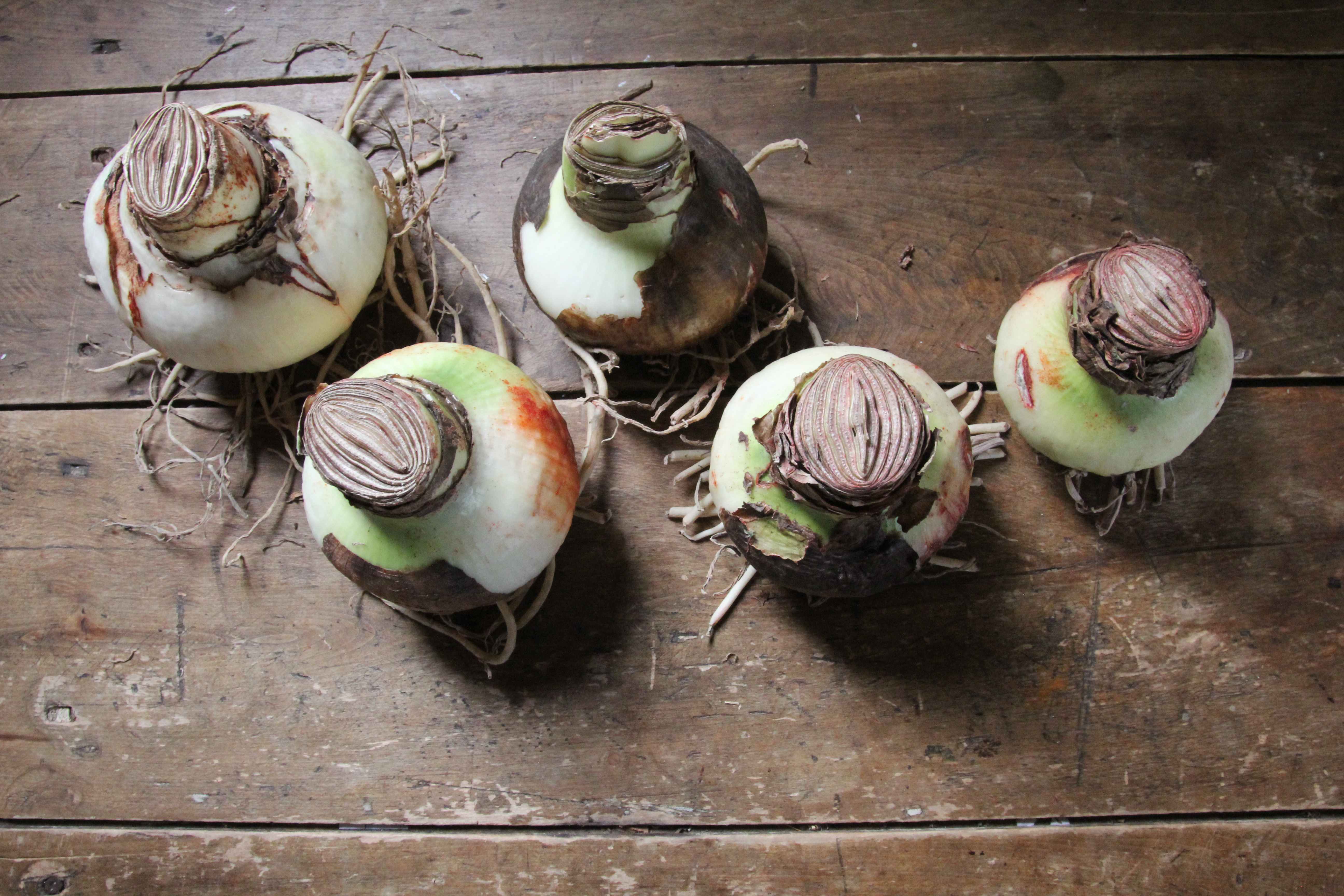
If you’ve shopped for amaryllis bulbs, you may have wondered whether there’s really much difference between one bulb and another. Do you need to care about the size of the bulb?
To get a good value for your money, the answer is yes. With amaryllis there’s a clear relationship between bulb size and performance.
Size
Amaryllis bulbs are sized by measuring (in centimeters) around the widest part of the bulb. In the photo below, the bulb on the far right measures 26/28 centimeters in circumference. The largest one on the far left is a full 8 cm larger, measuring 34/36 cm.
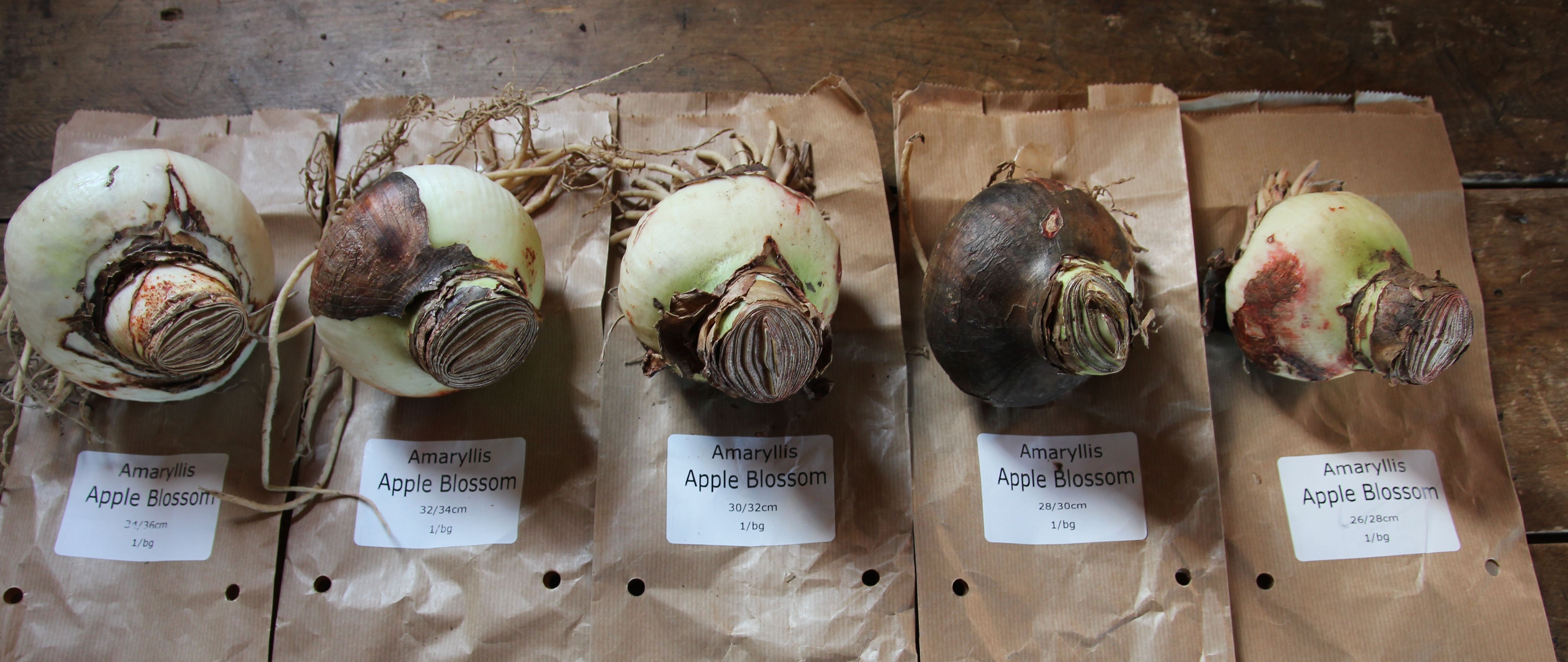
Performance
Plants don’t always behave like we expect them to, but as a general rule, the size of an amaryllis bulb tells you how many stems and flowers it will produce.
Bulbs are storage vessels, and the bigger the bulb, the more stored energy it has. This is why a small amaryllis bulb can produce a single stem with 2 or 3 flowers, while the largest size bulbs is able to produce 3 stems, each with 4 or 5 flowers.
Stem strength also varies depending on bulb size. Larger bulbs produce thicker, stronger stems.
Here are how many stems and flowers each size bulb is likely to produce:
26/28 cm – 1 stem (occasionally 2) with 3 to 4 flowers
28/30 cm – 1-2 stems with 3-4 flowers per stem
30/32 cm – 2 stems with 4-5 flowers per stem
32/34 cm – 2 stems (occasionally 3) with 4-5 flowers per stem
34/36 cm – 3 stems with 4-5 flowers per stem
Variety
This is another factor that plays into bulb size and price. An amaryllis variety that is widely available and easy to propagate is usually less expensive than a new variety that is in short supply or is difficult to propagate. It’s the same reason a common peony variety costs far less than one that was recently introduced by its breeder.
You may also notice that not all amaryllis varieties are available in every bulb size. For less common varietes, the sizes and quantities are limited by demand and by the growing season.
So if a flashy new amaryllis variety catches your eye, you can expect to pay a bit more for it. Shown below is a relatively new introduction, ‘Benfica.’
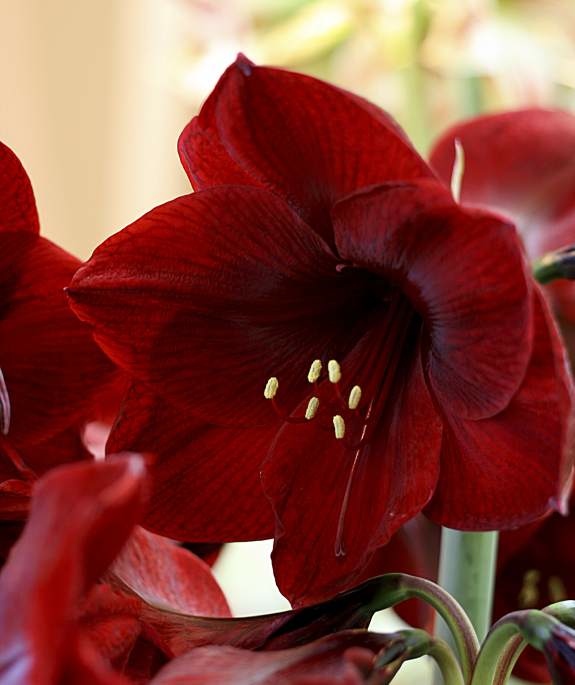
Getting Creative with Amaryllis
It’s important to know that there’s nothing wrong with smaller-size bulbs. In fact, planting a couple 26/28 cm bulbs together can give you a great look. You could add a few paperwhites or a couple pots of cyclamen as companions. Or you could pot up several bulbs and plan to use them as cut flowers.
When you want to get the biggest flowers and the most blooms from a single bulb, purchase the largest size bulb you can find. Since these bulbs send up multiple stems, usually a week or two apart, they will also give you the longest possible show.
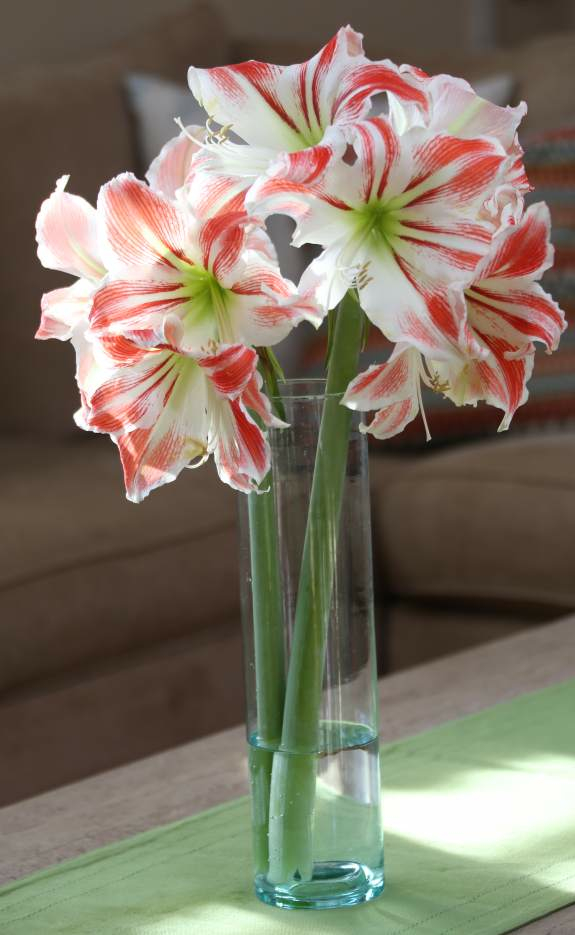
Other Facts About Amaryllis Bulbs
• Jumbo amaryllis bulbs, which are at least 34/36 cm, are bigger because they’re a full year older than the next size down. It costs more to keep these bulbs “on the farm” for an extra year and that’s why the price is higher.
• Some amaryllis varieties naturally produce smaller than normal bulbs. These include Cybister amaryllis, like ‘Evergreen‘, which have narrow, spidery petals, and miniature amaryllis, which have short stems and half-size flowers. The size of these bulbs shouldn’t be compared to full size varieties.
All amaryllis bulbs produce big, beautiful flowers. To make sure you get a good value for your money, pay attention to bulb size. The bigger the bulb, the more flowers you’ll get!

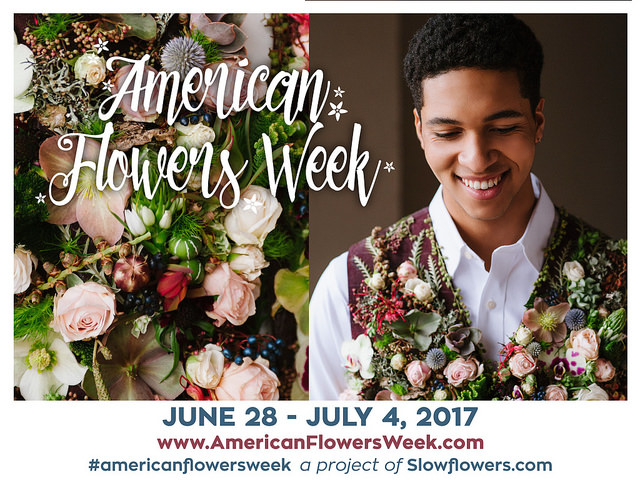
My pink Amaryllis has just bloomed and I have never seen 6 blossoms off of a single stem until now. Is this normal? Should I expect that to happen again next year?
Hi Janet, It’s hard to predict how many flowers an amaryllis will produce. Bigger bulbs usually produce more stems and more flowers per stem.
Some people have great luck saving their amaryllis bulbs from one year to the next. Check our website for information about how to do it. The more you pamper the bulbs during the summer, with sun, fertilizer and the right amount of moisture, the larger they’ll grow the the better chance you’ll have of getting lots of flowers again next winter. The best way to make sure you get a repeat performance next year is to buy new bulbs in the fall!
I have 7 blossoms off one stem. I hope it does this again
Hi Janet — glad to hear that your amaryllis is impressing you! If you want to keep the bulb and try to get it to bloom again next winter, read the article on our website. Here’s where you will find it: How to Get an Amaryllis Bulb to Rebloom
I have an amaryllis bulb with a stem with 10 flowers on it. Could this be some kind of a record! The entire plant has one main bulb with several smaller off shoots. A total of four stems are coming up. It looks like some kind of mutant plant.
Hi Nancy,
If you took a photo of this amaryllis, we would love to see it. Sounds pretty amazing! The larger (and more mature) the bulb, the more flowers it will produce. When amaryllis are grown outdoors (in frost-free climates), they can get very large.
Hello! I’ve got 2 amaryllis Picotee two years ago, but only one showed up one single beautiful flower. The bulbs are firm and became a jungle of green long leaves. I read somewhere that’s fine with them because “the bulbs are growing” and eventually will re-bloom with bigger flowers. BUT until now -this 2017 will be the 3rd year I have them- they are just the same size! Are they kidding me? I live in Moscow and I’ve read in a blog that I must not let it bloom by cutting the stem in order to size up the bulb. Is that right? I would really appreciate your advice. I love my plants and I have Lily Callas too.
Hi Lucy — not everyone is successful getting amaryllis bulbs to re-bloom (I am not). It sounds like you are getting your bulbs to flower each year, so consider yourself very successful! You are correct that the bulbs use their foliage to produce the energy to make new flowers. Under ideal growing conditions (or the controlled growing conditions in a greenhouse) the bulbs will gradually get larger over time. But amaryllis (actually hippeastrum) are tropical plants and Moscow does not offer their ideal growing conditions. If you want to make sure you get lots of flowers, purchase a new bulb that is 34/36 cm. We will be offering those again in the fall.
My Amaryllis ha 12 flowers on it’s single stem. Approx 30cm tall and leaf spread,. The flowers are smaller than the other 4 or 5 flower heads /stem. Any idea which variety it might be?
Hi Paul – If you email us a photo of your amaryllis in bloom, we may be able to help you identify it. Most of the bulbs commonly referred to as amaryllis are actually Hippeastrum. The cybister type of Hippeastrum produces smaller flowers and often more of them. You may also be growing the true amaryllis, Amaryllis belladonna. To send your photo, you can reply to this email or go to our website (www.longfield-gardens.com) and click on “contact us” at the bottom of the home page.
My 3rd year bulb is now 26 ” in. Tall and has a flower head but no flowers yet. Last year had 2 leafs and no flowers. How long will it take to flower and is this some kind of record for height!
Hi Joe. I have a 2 year old bulb that also grew very tall. I forgot about it in the basement and by the time I realized it was growing, it was already 2 feet tall. When the flowers opened, I cut the stem down to 12″ and enjoyed it in a vase.
MY AMARYLLIS IS 26″ TALL WITH 2 FLOWERS AT THE MOMENT…SHOULD IT BE THAT HEIGHT?..I ENJOY YOUR COMMENTS TYVM
Hi Bill – Two feet is not unusually tall. There are a couple factors at play when it comes to stem height. One is genetics. For example, all members of the Nymph series tend to be rather short (12-18″ tall). Temperature and light also have an impact on height. Stems will stretch out in a warm room with indirect light. If you feel like your amaryllis is too tall, don’t be afraid to cut the stem. They look beautiful in a vase and last just as long. Here’s a link to a recent post about that: How to Use Amaryllis as Cut Flowers